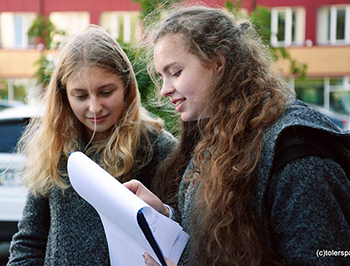
Oksana Ishchenko
Despite living in Kiev her entire life, Oksana Ishchenko (right in photo) had never been to the site of the Babi Yar massacre in Ukraine, on the same side of the Dnieper river. In fact, before she was invited to train to give a Babi Yar IWalk – an educational program that put on a walk around the ravine guided by testimony clips from the Visual History Archive – this year, Ishchenko hadn’t learned very much about Babi Yar.
“In school, we learn history so fast, we do not have time to think and to ask questions and to look for answers,” Ishchenko said. “This is why I got involved in the IWalk.”
That history Ishchenko was missing, she had the opportunity to review in preparation for this year’s IWalks, in commemoration of the massacre’s 76th anniversary. In just one week in 1941, SS, German police units and their auxiliaries shot nearly 34,000 Jews from Kiev to death at the Babi Yar ravine. It was one of the largest mass murders at a single location during World War II, paving the way for tens of thousands of Communist, Soviet and Roma prisoners to be killed in the same fashion in the subsequent months.
For the over 100,000 killed in total at the ravine, 100 testimonies on the subject live on in the Visual History Archive. Along the IWalks, which have been going on for over a year now, participants – high school students and community members – were able to walk through the historic site and through the Babi Yar memorial while watching those testimony clips from the Visual History Archive on tablet devices.
In addition to the clips participants watched on the tablet devices – which cover the history of Babi Yar and both pre-war and occupied Kiev, the stories of killing and of survival, the commemoration and the denial – participants heard from and got to ask questions to the interns leading the walks.
Ishchenko was one of the students trained by USC Shoah Foundation Ukraine regional consultant Anna Lenchovska to lead the Babi Yar IWalks this year.
“My first IWalk was quite successful,” Ishchenko said. “At first, I was very nervous and afraid I would fail to talk properly. As the excursion began, my fear went away, and my partner guide and I were confident in our knowledge. We quickly grew comfortable with the interactive chat with participants.”
Last year, Lenchovska recruited students to lead the IWalks because of their work with TolerSpace, a Kiev-based NGO developed in 2013 as part of a series of projects promoting tolerance under the Congress of Communities of Ukraine, to create an educational space around discussion of human rights and tolerance.
Many students who went on the IWalk last year were much like Ishchenko – they had never seen the site or learned at length of the massacre. Some said afterward that they hoped to bring their parents back to see the IWalks, or wished there was a museum with testimony clips at the site.
Ishchenko, a new recruit, was able provide these students with that opportunity and move them, all over again.
“I think it was cool,” Ishchenko said, “that kids got this information in a comprehensive form for their understanding.”